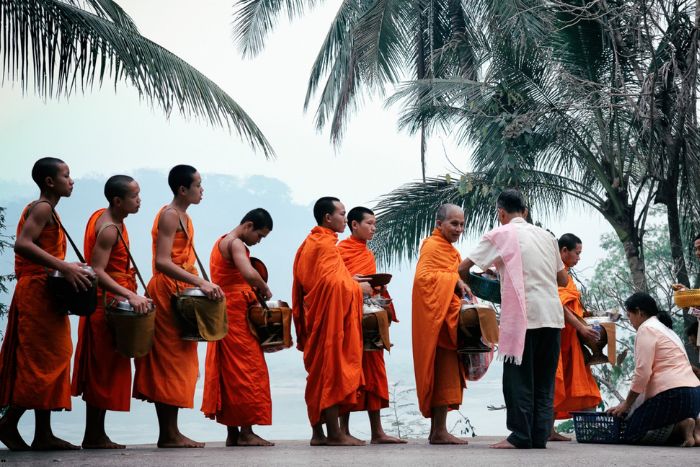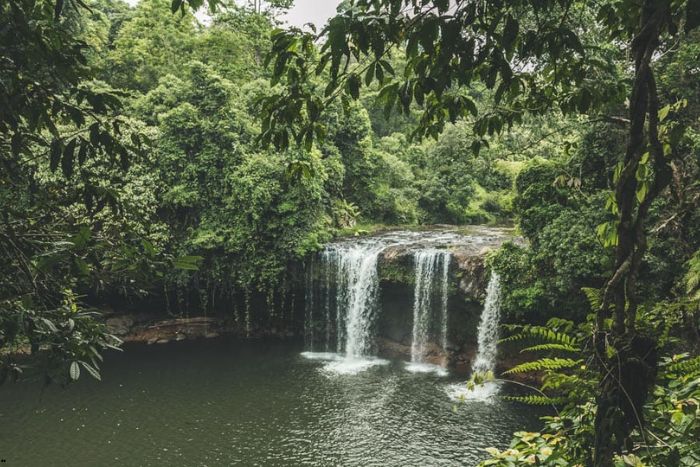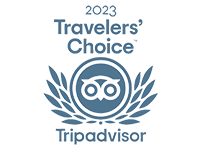Laos In July: Weather, Where To Go, What To See, Itinerary And FAQ

It's the rainy season, so is traveling to Laos in July feasible? With the highest humidity and rainfall of the year, it's important to be equipped with essential accessories to handle sudden downpours. However, these rains typically last only one to two hours, followed by dry weather, allowing you to continue your exploration of the Land of a Million Elephants. Read this article to learn more about the weather, festivals, must-visit destinations, and essential activities during your trip to Laos in July.
Table of Contents
I. Overview of Laos weather in July
- Average temperature: 26°C (79°F)
- Average precipitation: 245 mm
The frequency of showers in Laos in July is even higher than in June. In particular, the southern regions of Laos (Pakse and the 4000 Islands) experience longer rains compared to the north. However, the downpours mostly occur in the evenings and afternoons. After the rain, the sky clears up, and nature is at its peak, especially in the countryside and rice fields. During this time, Laos' rivers and waterfalls are at their most beautiful. With a very rainy climate and high humidity, road travel to mountainous areas like Vang Vieng or Luang Namtha can be more challenging due to slippery trails.
As for the temperatures in Laos in July, they remain fairly cool, averaging around 26°C (79°F). In northern provinces like Phongsaly, Luang Namtha, and Oudomxay, temperatures range between 25 and 26°C (79°F). In central and southern Laos, the capital Vientiane, and nearby areas such as Champassak and Pakse experience higher temperatures, between 27 and 30°C (86°F). Occasionally, there are sunny days that provide perfect conditions to admire the natural landscapes.

II. Special festival in Laos in July - Boun Khao Phansa
- Date: Usually takes place in July (based on the lunar calendar)
- Location: In temples across Laos
Boun Khao Phansa is an important Buddhist festival held in Laos in July. It begins on the day of the full moon and lasts for three months within the temples, marking a spiritual retreat for Lao monks. During this period, monks engage in prayer, and introspection, and do not leave the temple. Meanwhile, the local population visits the temples to make offerings, pray, and seek peace.
The festival is called Boun Khao Phansa, meaning "in the rainy season", symbolizing the start of these three months. According to monk Okath Pethsisanovong from Wat Si Muang temple in Vientiane, Lao monks study 84,000 Buddhist teachings on prayers, ethics, and doctrine during this time. At the end of each day, in temple ceremonies, the monks pass on the Buddha's teachings to the faithful. The festival concludes with Boun Ok Phansa, also known as the festival of the end of the Buddhist Lent, which takes place in October in Laos.

III. Best places to visit in Laos in July
1. Luang Prabang
When traveling to Laos in July, Luang Prabang is an ideal destination due to the cultural richness of the former capital and its stunning natural landscapes. Additionally, the frequency of rain in Luang Prabang is lower than in the central and southern cities of Laos, with showers mainly occurring in the evening and late afternoon.
This allows you to explore its picturesque streets lined with French colonial architecture while enjoying the peaceful atmosphere and warm hospitality of the locals. Must-see attractions include the Royal Palace, Wat Xieng Thong and Wat Mai temples, the Mekong River, Kuang Si Falls, the Whisky Village, and the Elephant Sanctuary in Luang Prabang.
2. Vientiane
For the capital city, Vientiane is a symbol of Buddhist culture with a long history that you shouldn’t miss during your trip to Laos in July. From ancient sacred temples to traditional stilt houses and unique historical monuments, Vientiane will enrich your stay in Laos.
You can visit spiritual sites such as Wat Sisaket, the Contemporary Art Museum, Wat Si Muang, and Ho Phra Keo even when facing rain showers. When the sun shines, admiring the That Luang stupa and visiting the Patuxay Victory Monument are must-do activities.

3. Paske
Pakse is a tranquil city to visit in Laos in July. Although sudden showers may occur, they quickly dissipate, leaving behind a lush and refreshed landscape. If you wish to explore the history of Laos, Pakse is a must-visit, as this small town has preserved many buildings from the French colonial era and various spiritual temples, such as Wat Luang, where Buddhism courses are taught to monks, Wat Phabad, Wat Phousalao, and Vat Phou temple.
Furthermore, Pakse is renowned for its enchanting natural landscapes, including the Bolaven Plateau, the Si Phan Don archipelago, Tad Yuang twin waterfalls, and Phou Asa mountain, among many others. It’s a true paradise for nature and culture lovers, especially if you visit Laos in July.
IV. Travel tips for Laos in July during the rainy season
If you’ve never faced tropical rains in Asia, the following tips will help you adapt and enjoy your trip to Laos in July, even during the rainy season. These recommendations should help you forget the idea that rain might hinder your exploration.
- Check the weather forecast: Showers are often predicted in advance through weather apps, allowing you to know when it might rain during the day. Prepare accordingly with accessories like an umbrella or a raincoat.
- Follow the advice of guides, receptionists, locals, or travel agencies: They can point out places to visit or avoid during this time, helping you steer clear of unnecessary travel or dangerous areas due to flooding or landslides.
- Pack appropriate clothing, such as quick-drying cotton or linen garments, along with a light hooded jacket for rain protection. Don't forget waterproof shoes or sandals.
- Other essential items to consider include an umbrella and a raincoat, which are readily available in local shops. Also, remember to bring basic medications for headaches and insect repellent, as weather changes can sometimes affect your health.

We hope these suggestions will be useful for your journey to Laos in July. If you have any questions, don’t hesitate to contact Autour Asia, your Laos tour agency. We’d be delighted to assist you in crafting a personalized itinerary that goes above and beyond your expectations.
There are several border crossings where you can enter Laos by land. You can consider some tours such as Laos Vietnam Cambodia 21 days or Laos Cambodia 15 days,... Besure to check visa requirements and transport schedules, as crossing borders can sometimes be time-consuming. Feel free to contact AUTOUR ASIA - best Vietnam local travel agency for the best price and best experience.
Travel to Laos, pay attention to power plug travel adapter for Laos. This country uses Type A, B, C, and E plugs, and the voltage is 230V with a frequency of 50Hz. If your devices use a different plug type, you will need a power adapter. It’s also a good idea to bring a voltage converter if your devices are not compatible with 230V.
Travel to Laos in July, as well as others month, tipping is not mandatory, but it is appreciated, especially in tourist areas. Tipping in Laos, In restaurants, it’s customary to round up the bill or leave small change (around 5-10%). For hotel staff or tour guides, a tip of around $1-2 USD per day is appropriate, depending on the service.
Related travel guide
Other similar articles
CUSTOMIZABLE BY LOCAL EXPERTS
Personalized trip at the original price!
REFUND GUARANTEE
We believe in our work and promise to give you money back.
GOOD PRICE / QUALITY
95% satisfied more than expected!
24/7 LOCAL SUPPORT
We are always available online to provide assistance at any time.
Most read articles
Autour Asia is highly recommended on
Embracing the mission of "Satisfied more than expected" and providing authentic experiences, we have received numerous recommendations on reputable travel forums:























